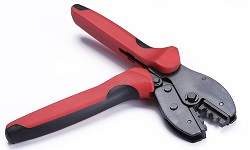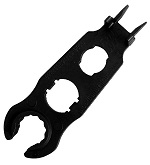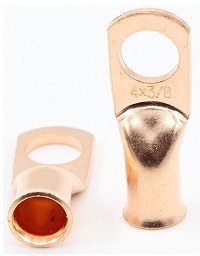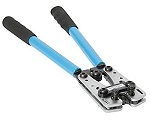
|
|||
|
Solar Accessories: Cables and Connectors
In the previous article in this series, we covered the fundamental cable types used in an off-grid solar power system. Be sure to read that article, or go back to the first article in this series for a complete overview of how to design an off-grid energy system. In this article, we describe the typical connectors used in off-grid applications. Remember, in solar installations the panels and batteries are always on, so make sure that all the breakers are off when making cabling connections. Even so, be careful when connecting batteries together. Connector Types
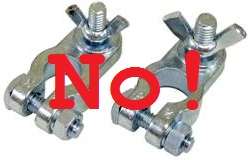
Although some connections, such as those inside the combiner box, will be made with screw terminals, your off-grid solar application will use two types of connectors, cable lugs and weather-resistant panel connectors. It is important to note that you will never use the automotive-style battery clamps, as shown to the right. These terminals never make a great connection, and corrosion inevitably begins to form in the space between the battery post and the clamp. MC4 or Other PV Connector
One of the most popular solar panel connector types is the MC4 connector. This connector is shown to the left. Other PV connector styles have similar features, so these guidelines will be applicable. First note that the cable enters the connector through a special gland, which can be tightened around the cable. This waterproof seal allows the connector to be used in the weather. However, it is good practice to still tuck the connectors out of the weather as much as possible, such as under the panels themselves. This gland is designed to take a small range of input cable sizes, so be sure to pick a cable size and connector that are compatible with each other. Not only does the sealing gland require a specific cable size, the connecting crimp pins also are designed to accept a specific range of cable sizes. To correctly attach the crimp connectors, you will also need a crimping tool, as shown on the right. Be sure to get a crimper tool compatible with the specific connectors you intend to use, as there are some variations between manufacturers. Also note that the connectors are unambiguously keyed with a male end and a female end. This mating system is easy to connect without any tools at all, but is practically impossible to separate without an MC4 tool, shown to the left. The prongs on one end of this tool press down on the retainer clips which engage the female end. When done correctly, the connector practically falls apart with very little effort. These tools are very handy if purchased in pairs as they can then be used as mar-free tools for tightening the glands. One void on the wrench holds the male or female end, respectively, while the jaws are used to tighten the gland nut. These little wrenches are very inexpensive and are worth having several lying around. We use a 3D printed tool for the same purpose. Always remember to flip the combiner breakers to off before making or breaking any MC4 connections, and never connect the MC4 connectors on a single panel together just for fun. Although the panel can handle the current, the connectors cannot. Be sure to have some extra MC4 connectors lying around for when you forget and hear that pop. Cable Lugs
The other major type of wire connector in an off-grid system is the cable lug, as shown to the right. As noted previously, the clamp style cable connector is unacceptable in solar applications. When selecting a deep-cycle battery, then, be sure to select a model which features a threaded terminal post. The exact size of the post is not as important as it must have them. To pick the correct cable lug, you will need to know two pieces of information. The first is the size of the cable you are using. As we will see in the next section, you will use several cable sizes. The second piece of information is the size of the threaded terminal posts on the batteries in the array, or in some cases, the terminal posts on chargers, inverters, breakers or other accessories. Looking at the photo, these parameters are listed on the lug itself. In the example to the right, this lug is intended for use with 4 AWG cable, and fits a 3/8-inch terminal post. Clearly, your off-grid project will need a variety of cable lug sizes. You will also need a cable lug crimper, shown to the left, particularly a model, such as the one shown, which is capable of crimping a variety of lug sizes. There are some impact lug crimpers available, but we find the handheld crimper to be more convenient. The more expensive hydraulic lug crimpers do not seem to be required for the applications we have encountered. Finally, to make the best connections, brush both the wire and the inside of the lug with flux, crimp, use a blowtorch to heat the lug and then solder the cable end inside the lug the old-fashioned way. This creates the strongest bond, both physical and electrical, and prevents corrosion from eating away at the inside of the lug. A perfectionist would then seal the insulation gap with a length of heat-shrink tubing. Next article: Cable Connections ... |
Announcements
Amateur Radio Solutions Available Our development staff now includes Amateur Extra radio FCC licensees, increasing the breadth of our existing wireless development services. Posted: 12 Nov 2015 Details Here |
© 2001 - 2016 SoftBaugh, Inc. All rights reserved.

